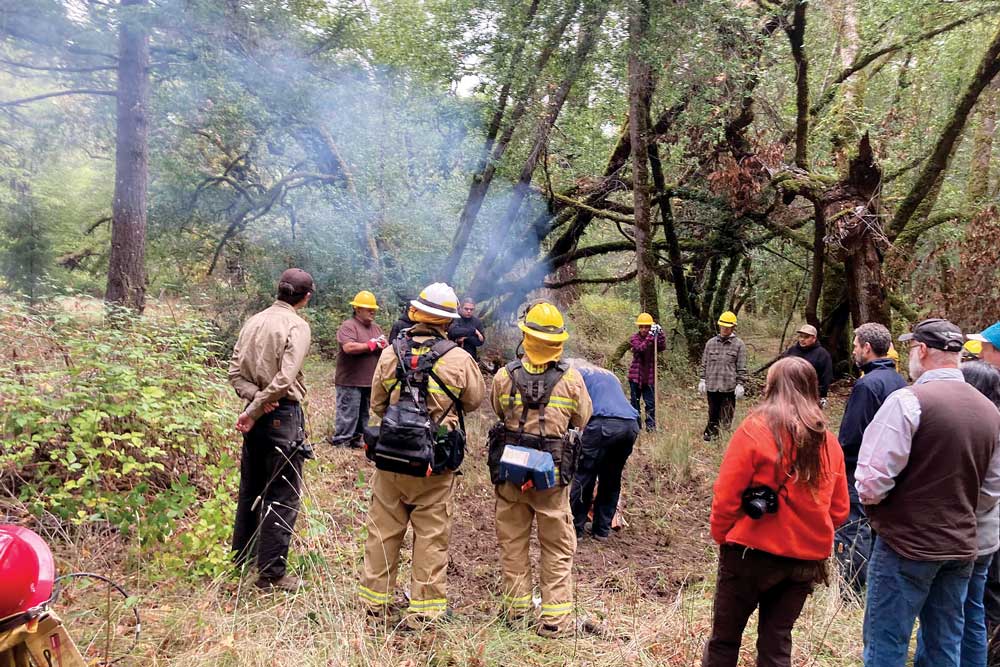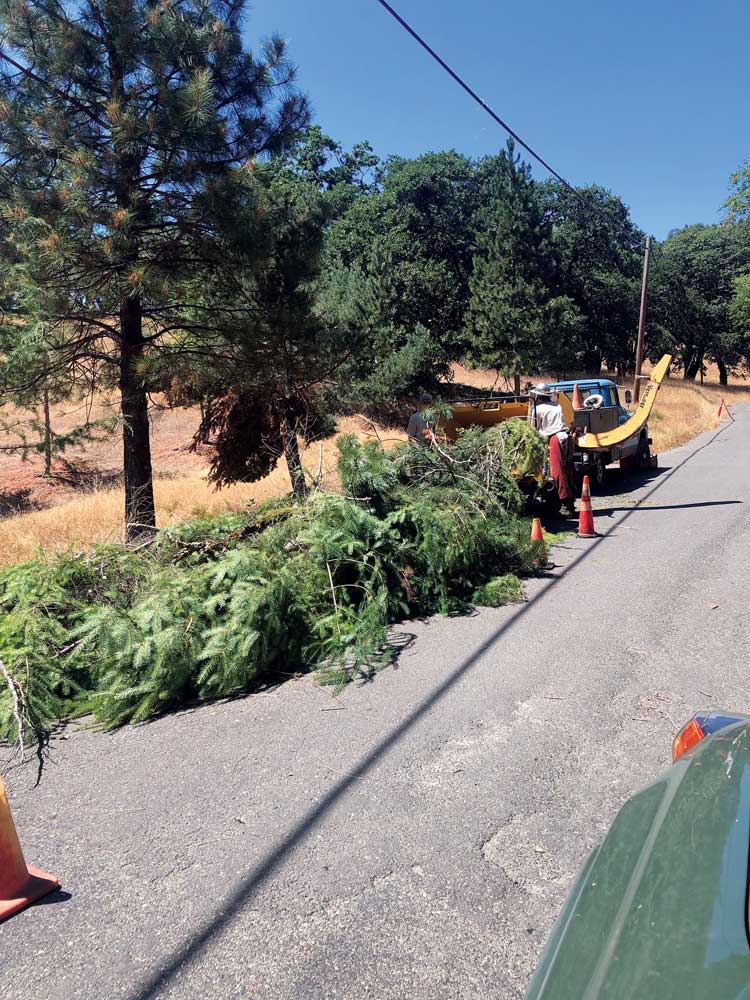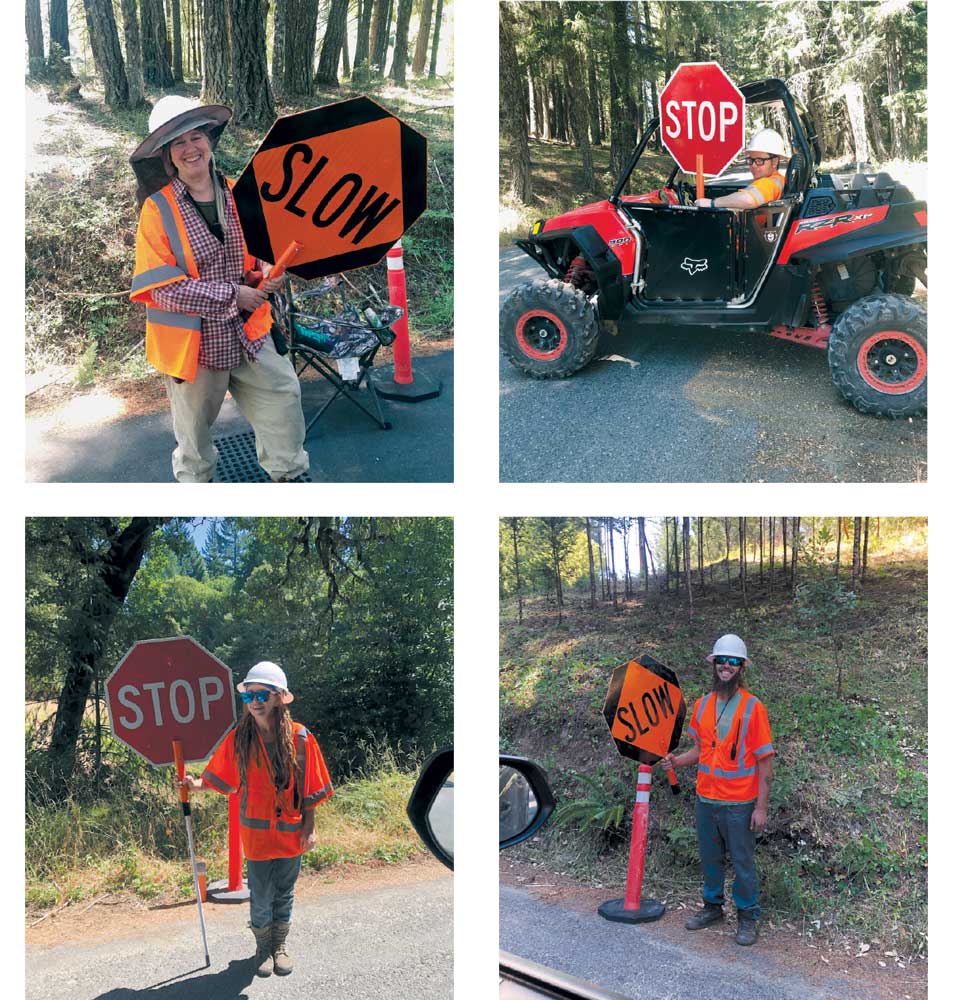Southern Humboldt Fire Safe Council: Part of the Web of Groups Working Together to Rebuild Our Relationship to Fire

Submitted by Gail Eastwood, Chair, Southern Humboldt Fire Safe Council
If you watch busy ants around an anthill for a while, you’ll see many ants industriously moving a bit of grain or chaff or something. It appears to be part of a coordinated effort to achieve some mutual goal. But where is the commander? Who’s got the big plan and is in charge of getting it done? It’s clearly working, because you see the viable ant community and its many apparently able, fed, and sheltered ant citizens. Fire organizations in Southern Humboldt can look a little like that. Each works enthusiastically on their own program, their own priorities, not governed centrally. But all are essentially cooperating around the common goal of re-shaping our relationship to fire in our environment.
We want safety for ourselves, for our forests, for all the other living beings we share this place with. Many fire-related organizations, mostly volunteer, have sprung up in Southern Humboldt County over the past 20 years to serve this goal. At the local level, people are aware of local needs and priorities and are willing to work for them. These freestanding groups receive support from larger organizations with greater service areas, including governmental bodies and private non-profits. What are these local organizations?

All photos this article by Kim Phelps, unless noted
Fire Companies and Departments
In rural areas of California, we’re used to seeing various areas create and support volunteer fire companies and volunteer fire departments. If we weren’t so accustomed to this, we’d be amazed that crucial functions like fire protection and emergency response can be assigned to local self-governing organizations with small teams of volunteers! They are regulated (but not governed) by official government structures.
Local Neighborhood Groups
The Southern Humboldt Fire Safe Council (SHFSC) has been around almost 20 years. We now see an increasing number of local groups forming in our service area. Many of them appeared in the last five years. It could be chaotic—and yet, for the most part it all works together. Creativity and power emerge from the base of local activism. Larger levels of organization fertilize and empower this base. It’s again amazing that this profusion of groups, mostly of volunteers, could be taking on the essential function of wildfire readiness.
We can’t do justice in this short article to the work of these local groups, because so much is being accomplished. Here are just a few inspiring examples among many. Each group looked at what needs to be done in their area and took action.
The Greater Palo Verde Fire Safe Council has been organizing regular work parties to create fuelbreaks along their main access road and defensible space around the homes of vulnerable elders. Their efforts and willingness to obtain landowner permission attracted outside funding to their area.
The newly formed Ettersburg Fire Safe Council has received technical assistance funding. This included support for becoming a 501(c)3 non-profit. More recently, they received a $500,000 grant for defensible space work, in collaboration with the Briceland Volunteer Fire Department’s new fuels reduction crew. This crew will employ firefighters in the off-season.
The Whitethorn Fire Safe Council built a Neighborhood Emergency Support Team (NEST). The NEST network communicates with the neighborhood, making efforts to care for vulnerable individuals in case of fire and other emergencies.
The Garberville group, now a recognized Firewise community, is busy enacting their Firewise action plan—tabling, distributing leaflets, offering consultations on defensible space and fire-hardening of homes. They received funding to distribute fire blankets to homeless encampments, to empower these residents to control fire escaping from campfires.
The Benbow group, also Firewise certified, provided impetus and strong support for the expansion of Garberville’s fire district to include them as well as other areas not previously in any fire department’s service area.

Organized Planned Burning
We’re excited about the numerous local burns that have happened thanks to the dedication of the Southern Humboldt Prescribed Burn Association (SHPBA) and its parent, the Humboldt County PBA. Through the work of the SHPBA and its parent, the Humboldt County PBA, numerous local burns have happened. The Wailaki Cultural Burn Crew, with the Wailaki non-profits—Native Health in Native Hands and Eel River Wailaki—implemented the first Community Park cultural burn. Developing the culture of and resources for burning is critical to making our forests more fire-resilient. Fuels reduction by hand work and equipment work is necessary at this point in time. But the fuels problem is too big for these methods alone to resolve. For that, we need to burn on a landscape level.
We are on the path to getting more comfortable with and more skillful in handling the presence of fire. We do that, in part, by working with one another on planned burns. Neighborhood burns give many local residents their first taste of purposeful burning. Burning as a neighborhood can be exciting and fun—and as we do this we’re building the experience and expertise we need.
Non-Profits
Trees Foundation is one among a number of organizations that support fire-related efforts in our region. Trees deserves special recognition as a locally based organization with a new focus on fire. Through contracts and fiscal sponsorship they are helping to funnel money to our area and its local groups. They are working to foster the collaboration of fire-related groups and organizations in the Southern Humboldt/Northern Mendocino region.
Coordination and Collaboration
Getting back to our anthill metaphor—how is this coordinated? No one individual, no one organization, seems to be in charge of all this impassioned effort! How do resources from larger units—like the big bucks from national and state sources—filter out to more local levels? How does the research on fire safety, wildfire preparedness, and protection get to the people who need to protect their homes and lives? It turns out that there are groups and organizations at all these nested levels (local, regional, county, state, federal) that have taken on functions of coordination and communication of information. But there is no command structure here. Instead, we see an elaborate dance of collaborating, helping, inspiring, and supporting.
You’ll find a lot of the power and energy in all of this at the local level. Organizations that serve larger areas offer coordination and resources to these areas. The SHFSC, for example, serves the local fire safe councils in its service area. It also serves other forms of local fire-preparedness organizations—Firewise Communities and other more informally organized fire safe groups. The SHFSC is in turn served by the Humboldt County Fire Safe Council. The California Fire Safe Council serves all these nested levels. It’s an unusual but not hierarchical way of working together that inspires creativity and initiative at all levels. (Want to have a fire safe council in your neighborhood? Forming a neighborhood FSC involves about as much red tape as forming a book club!)
One key planning and coordination effort (among numerous efforts at various levels) is the County Wildfire Preparedness Plan (CWPP). Counties update their plans about every five years. This year, for example, both Mendocino and Humboldt counties are starting the update process. The plan attempts to gather and prioritize actions and projects. Funding sources want your proposed project to appear in this plan. In Humboldt County, the county FSC reaches out to its regional FSCs to help with revision of the plan. The SHFSC, in turn, will reach out to its various neighborhoods and residents to identify priority actions. There are gaps, where no VFD exists to serve, where no fire safe group has yet grown up. How will the gaps be filled after we become aware of them in the planning process? Developing an outreach plan that would foster the filling of these gaps will likely fall to the regional and county-level FSCs.
The interwoven net of collaboration is dizzyingly complex. This article only sketches a segment—there’s a lot more happening here. The county Resource Conservation Districts play an important role in our rural part of the state. Other organizations that are woven in include State Parks, the Coastal Conservancy, North Coast Resource Partnership (NCRP), CAL FIRE, and private companies like Mendocino and Humboldt Redwood Companies. Private landowners, including large ranches, also take on an essential role. Any large project is likely to involve the skills and effort of many people and a number of organizations.
Conclusion
We have become aware of the errors of the past in relationship to fire. The well-intended suppression of fires, on top of clearcut logging, created a fuels problem we’ll spend many years dealing with. We learned that not allowing fires to burn only increases the danger of wildfire in the long run. We have started to rebuild our relationship with fire in intimate local detail. What do we need to do in order to make it safe to live a human life in a place where fires burn? We are learning bit by bit. We are learning how to make the landscapes around our houses and other buildings fire-resistant. We are learning to build structures that resist fire. We are learning to tend our forests in ways that help them resist catastrophic fire. Making these changes requires us to work together, and to work with the forces of the natural world. In rebuilding our relationship to fire, we are starting to rebuild our relationship with the natural world.
For more information: sohumfiresafe.org
